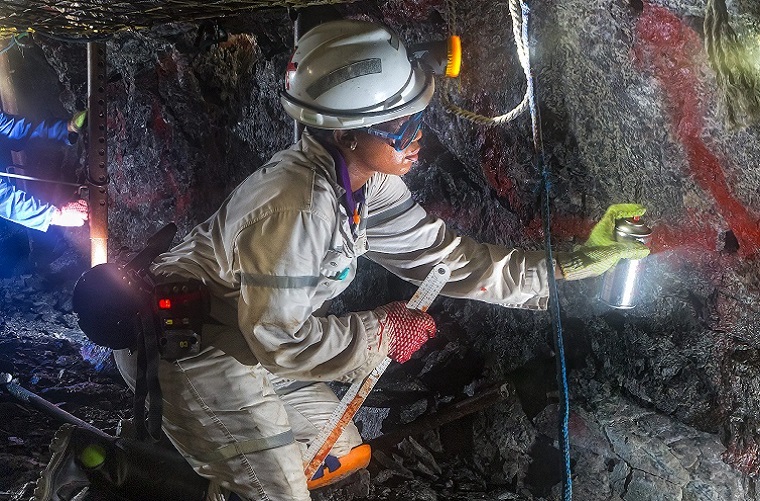
21 Sep Gender-based violence in SA mines is an open secret
Women now have a place in a labour-intensive workplace with heavy machinery designed for muscle, but a rough industry is struggling to get to grips with their presence underground. Tholakele Nene investigates
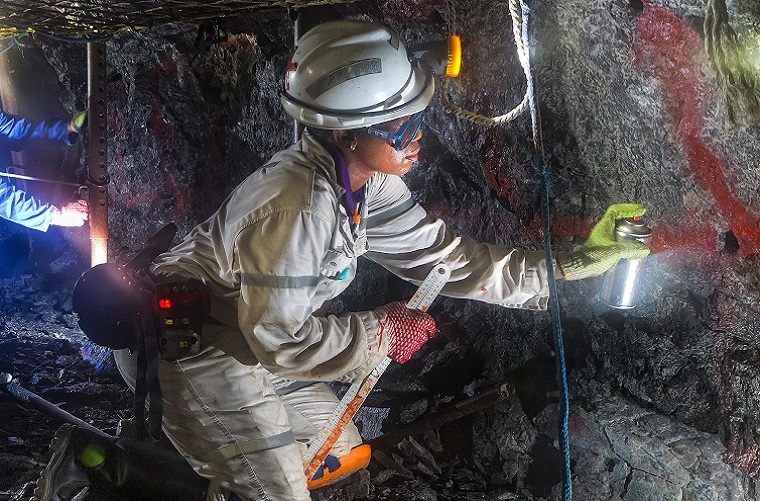
Harsh environment: Underground tools, overalls and protective gear are generally not designed to suit the needs of women miners. Photo courtesy Anglo American
In 2012 South Africans were first introduced to the story of Binky Mosiane, a young mother, daughter and female miner who was found lying in a pool of blood with a used condom next to her lifeless body.
She was attacked during her underground shift at North West Anglo Platinum’s Khomanani mine on February 6 2012. A sole breadwinner, she died at the age of 27.
Like many of the female mine workers who make up 10% of the workforce in South African mines, she was powerless to defend herself in the 90% male-dominated industry.
Prior to 2002 an underground mine shaft was no place for a woman. Then the South African mining charter introduced a clause stipulating that female miners need to make up at least 10% of a mine’s staff, lifting the previous ban.
Women now have a place in a labour-intensive workplace with heavy machinery designed for muscle, and a rough industry is slowly getting to grips with their presence underground.
There are still practical challenges and safety issues that women face on a daily basis, such as verbal harassment and physical abuse in the form of rape, which either goes unreported, or as in Binky Mosiane’s case, results in loss of a life.
The safety of female mine workers is a growing concern and requires a shift in policy and legislation to protect them against being treated as sexual objects rather than colleagues, says Sanki Molefe, a female miner and head of the National Union of Mineworkers’ Rustenberg Women’s Structure.
In some instances women in mining still have to perform sexual favours to get a promotion, and those that refuse end up as victims of sexual harassment, Molefe said in a recent interview with SAfm radio station.
“We are mindful that women are exposed to harassment and abuse from their male counterparts due to patriarchal tendencies,” Molefe said. “In most cases you will find that women get promoted as a result of providing some sexual favours and those who refused to be part of those activities at the end of the day become victims of sexual harassment and are overlooked.”
The rape trend
In March 2015 a female miner at Thembelani Mine, owned by Anglo Platinum, was attacked and raped in the women’s changing rooms while taking a shower, by a suspected illegal miner. The attack took place at work during her morning shift at around 4am with a security guard on the premises, it was reported.
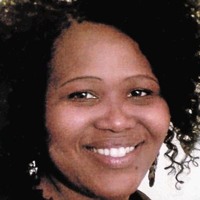
Binky Mosiane was killed while working an underground shift alongside 13 male mine workers. Photo courtesy Workers World Media Production
In November 2015 the Centre for Applied Legal Studies at Wits University’s School of Law submitted evidence of gender-based violence underground to the United Nations Commission on Human Rights.
“The phenomenon is occurring in part due to the regulation that requires 10% of all mineworkers be female. This small percentage, however, means that women are a minority of underground workers and, as such, are extremely vulnerable to sexual
violence,” the centre said.
“But it is not only the regulations that are the cause of this harm; contributing factors include gender norms in mining, lack of security and a lack of policies around gender-based violence in mining or the implementation thereof. In some instances, mines will pair women together as a form of security; however, the homogenous makeup of the male-dominated mining industry makes a mockery of this pairing.”
The centre had partnered with the South African Medical Research Council, as part of a project commissioned by the National Prosecuting Authority, to study the prosecution and adjudication of rape matters reported to the police.
The 2008 study found that only one out of nine women who were raped report it to the police. Out of 2,064 cases of rape looked at during the study, only50.5% of the cases resulted in the arrest of the rapist.
“Only 42.8 % of perpetrators were charged in court, and trials commenced in less than one in five cases. The conviction rate, which includes lesser crimes than rape, was at 6.2% (one in 20 cases),” the study found.
Binky Mosiane’s case followed the trend: there were still no arrests 18 months after her death. Media production house Workers World Media Production was one of the key role players who worked tirelessly to get justice for her.
“We heard about Binky’s story from our labour community forums and sent someone to the police station to check on the status of the case,” said Dibuseng Phaloane, a field worker at the production house.
“The police officer at the station said that Binky’s death was part of a sex scandal”. There were rumours of women having to perform sexual favors to get the men to do some of the work for them, to not slow down the team and affect the performance bonuses, and this was why the case had not been receiving much attention.
Workers World organised marches and awareness campaigns among the labour community, and as a result the case finally made headway in October 2013, when suspect Tutu Rooi Oliphant was arrested. According to media reports, the case was postponed four times before Oliphant was convicted on November 28 2014.
The Mogwase High Court found Oliphant guilty of raping and killing Mosiane, and sentenced him to 50 years in jail. He is also serving an additional 25 years for previously raping a five-year-old girl.
In addition to the conviction, Workers World was also able to get the mine to take responsibility for not ensuring the safety of Binky Mosiane by financially taking care of her family, Phaloane said.
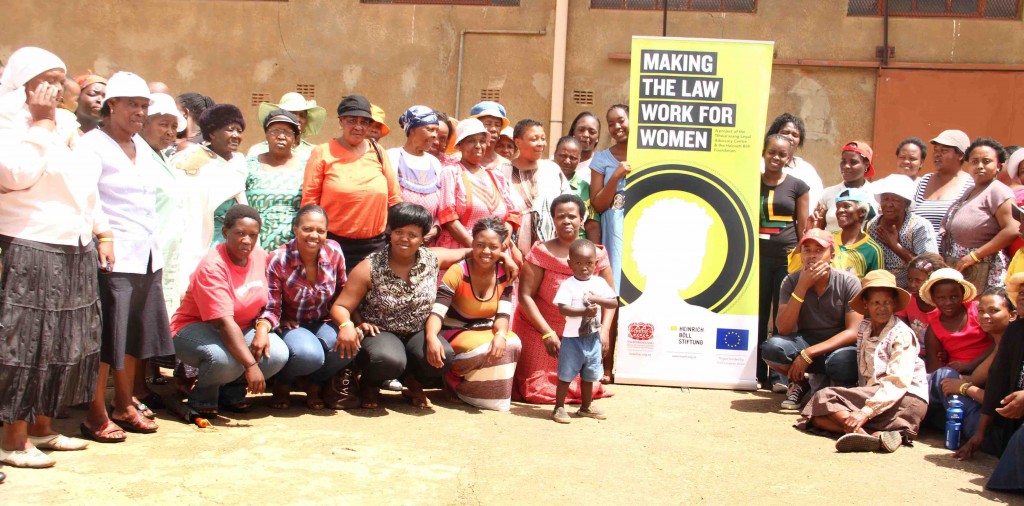
Tswaraganang Legal Advocacy Centre to End Violence Against Women is one of a number of non- profit organisations that work with women to ensure that survivors and victims of gender-based violence get the justice they deserve
Unlearning centuries of sexism
Women in mining had been “thrown in underground haphazardly into work teams where you find one woman for every 10 men there. There was a lot of room for mischief,” said David van Wyk, a lead researcher at the Bench Marks Foundation, in a January 2014 interview.
Women had told the foundation, which monitors corporate social responsibility, that the challenges they experienced underground ranged from unsuitable overalls and tools to being reduced to “skivvies” and performing sexual favours to advance.
“What happens at the end of the month is, if the woman wants to increase her income, she becomes involved in sex trade,” Van Wyk said.
It seems that even the death of Binky Mosiane has done little to improve working conditions for women in the sector, according to Phaloane. She said there still needed to be a shift in policy and laws designed to protect women in mining.
“I believe that we need to force implementation of measures to enhance safety of women and also see that we improve the working conditions and interaction between female workers and the working station.”
For instance, she said, the machinery and tools that are used in the mines were designed to suit the physical attributes of men, not women. “Even the overalls and the protective equipment are designed for men, and are not comfortable or practical for women.
“There’s also the issue of toilet facilities underground, which are also shared.”
NUM’s Molefe feels that even though there is still a lot to be done, the wheels are slowly turning for the better. She said in some mines protective gear had been revised to suit the build of women and that separate toilet facilities had been provided underground on some mines.
“After the Binky Mosiane case there was a directive from the minister of mineral resources to say that no woman or any individual is allowed to work alone, especially in isolated areas,” Molefe said.
Tackling the beast
So what can be done for all female miners to feel safe and to see the change Molefe is referring to?
According to the Centre for Applied Legal Studies, the position of the mines is that gender-based violence underground is a criminal justice matter, not an issue for which mining companies take responsibility.
“This is incorrect and inconsistent with South Africa’s constitutional regime, which applies to both the state and juristic entities such as mining companies,” the centre said in its submission to the UN.
“Specifically, there are two legal mechanisms that could trigger the liability of mining companies for these violations. The first is the principle of vicarious liability under the law of delict. The second is in respect of health and safety standards under labour law. Both these standards need to be tested, with the hope that successful litigation and advocacy will lead to legislative provisions which are binding on multinational corporations to prevent sexual violence underground.”
Workers World Media seeks justice for victims through campaigns, in particular its “Stop violence against women” campaign that has a special focus on the mining industry.
“We aim to expose the ineffectiveness of the police and the National Prosecuting Authority in ensuring justice for women. We campaign for the government to ensure that they improve care and justice for women victims, and also pressurise those in power and big businesses to end violence against women,” said Phaloane.
In response to Oxpeckers questions about what it was doing to ensure the health and safety of women in mines, the Department of Mineral Resources said in a statement that it administers the Mine Health and Safety Act, “which provides for the protection of the health and safety of all employees and other persons at mines.
“Historically, the South African mining industry has been a male-dominated sector and the employment of women is relatively new. The Constitution recognises gender equality as the cornerstone of South Africa’s democracy.”
Incidents of sexual harassment and ill-treatment of women underground were a serious concern for the Department, the statement said. “To this end, personal protective equipment for women has been developed, as well as regular educational and awareness campaigns at mines on safety and security and sexual harassment.
It is the responsibility of all in the industry to work towards changing perceptions of the industry as being for men-only. The legislation governing health and safety is being strengthened to ensure that the safety of women is adequately addressed.”
The department mentioned that a Health and Safety Summit would be held later this year “to take stock of commitments made in 2014, and identify areas for improvement in terms of the health and safety of women, among other objectives”.
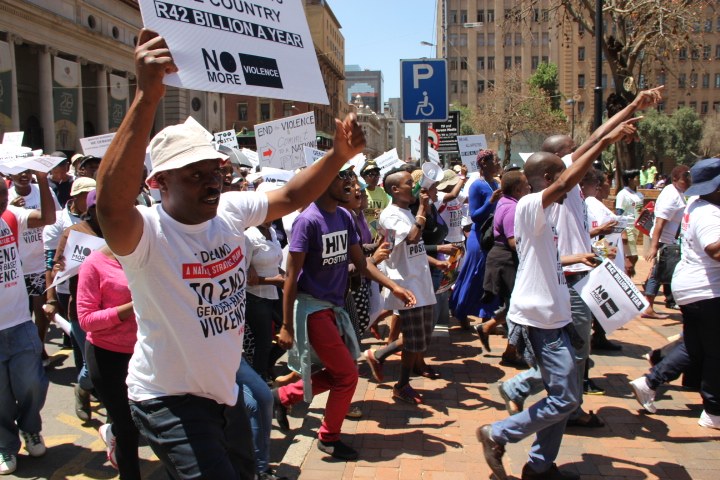
Men join a 16 days of activism march to protest violence against women. Photo courtesy Tswaraganang Legal Advocacy Centre
Bringing men into the conversation
If South Africa is to deal with gender-based violence effectively, men need to join the conversation.
Sonke Gender Justice is an organisation that is working with men through educational programmes and workshops to help deconstruct traditional, oppressive male views of women.
“We look at gender norms transformation, how to change how men view women, and how men understand manhood, often associated with being strong and taking risks.
“There is a belief that we own women, and we talk to them as children, using terms such as mntwana (baby). Language on its own shapes understanding”, said Patrick Godana, Spokesperson for the men-care programme at Sonke Gender Justice.
“How do we look at women as colleagues, how do we change behaviours? Because no one is born violent, violence is learned behaviour that can be unlearnt.”
He said it was just a small percentage of men that are messing up the image of men.
Sonke through the men care program exposes men to care work, which includes working with children and women to change the cultural constructs of the role of a man and the role of a woman. It is attempting to create an understanding that women and men can co-exist peacefully, and that women are not the property of men. – oxpeckers.org
#MineAlert is a website and mobile app that alerts residents and organisations to mining applications and licences in their regions. Use the app to track information on North West Anglo Platinum’s Khomanani mine here
Tholakele Nene is an Associate of Oxpeckers Investigative Environmental Journalism. This investigation was sponsored by #MineAlert and Code for Africa, and was syndicated through the African Network of Centres for Investigative Reporting. It first featured in the Mail & Guardian newspaper on October 7 2016.
